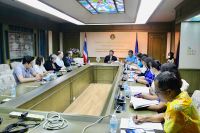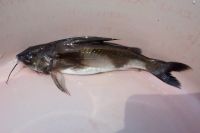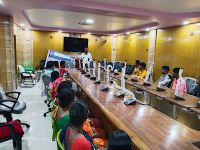The first conference of the International Artemia Aquaculture Consortium (IAAC) will be organised on 9 September as part of the same premises as the Larvi '24 Conference, in Ostend, Belgium. This is a hybrid event, with participation possible both in person and online via Zoom. In the morning session (open to all larvi participants), the following IAAC members will give presentations: Yeong Yik Sung (Malaysia), Patrick Sorgeloos (Belgium), Simon Wilkinson (Thailand), Sui Liying (China), Stephanie De Vos (Belgium), Brad Marden (USA), Phil Brown (USA), Yathish Ramena (USA) and David Johanson (Belgium). A detailed programme will be available shortly. Participation in the IAAC conference is free, but people attending in person are requested to indicate your interest to attend it on the Larvi registration form. The Zoom link for virtual participants will be announced shortly.
NACA's newly appointed Director General, Dr. Eduardo Leano, along with staff, paid a courtesy call to Mr. Bancha Sukkaew, the Director General of the Department of Fisheries (DOF), Thailand, and directors of DOF's divisions. Discussions centered on ongoing projects between NACA and DOF and explored opportunities for collaboration both in Thailand and the wider region. Mr. Sukkaew emphasized the need to improve food security in the Asia-Pacific region and the importance of cooperation in information sharing and R&D to enhance productivity and reduce costs. Thailand is currently participating in a NACA project on Knowledge brokering for nature-based solutions in aquaculture transformation in Asia-Pacific. The Thai team is identifying innovations and nature-based solutions in the aquaculture industry, as a contribution to the regional Aquaculture Innovation and Investment Hub, presently in development.
In this issue:
- Scientific aquaculture to promote better livelihoods for Scheduled Caste farmers.
- Rainbow trout in Jammu and Kashmir: Present status and strategies for expansion.
- Community participation in marine ornamental aquaculture: An integral approach on livelihood empowerment of islander women and conservation of reef ecosystems at the Lakshadweep Islands, India.
- Training programmes organised by West Bengal Fisheries Department in South 24 Parganas in the beginning of 2024.
- Exploring the possibility of captive production of a near threatened catfish, Rita chrysea for Indian aquaculture.
- NACA Newsletter.
Rita chrysea, a member of the Bagridae family, is a medium-sized freshwater catfish predominantly inhabiting the Mahanadi River system, coursing through the states of Chhattisgarh and Odisha in India. It has been classified as Near Threatened by the IUCN. Researchers at ICAR-CIFA, Bhubaneswar, have achieved successful breeding and rearing of R. chrysea in an intiative that aims to to popularise the species through training programs for farmers. This article describes methodologies to induce spawning and rear the larvae of R. chrysea and its performance in captivity, potentially paving the way for its adoption as a mainstream aquaculture species. Furthermore, the insights provided in this article may contribute to ensuring the captive breeding and rearing of two other species, R. pavimentata and R. rita, in the future. These species, belonging to the same genus, dominate Indian river systems.
Fisheries and aquaculture are crucial sources and contributors of nutrient-rich food, income, and livelihoods for many people in West Bengal and across India, creating valuable rural employment opportunities and fostering integrated rural development. Efforts are being made by the Fisheries Department to disseminate scientific knowledge about improved techniques of fish culture to fish farmers (progressive farmers, small and marginal farmers) by imparting hands-on training to them. The aim is to increase fish production through various means like bringing more water bodies under scientific fish culture and ensuring access to nutritionally balanced fish feed and high-quality fry and fingerling-stage fish for fish farmers. Training serves as an important mechanism for the transfer of technology and improving human skills regarding the developmental process This article describes recent short-term training programmes by the West Bengal Department of Fisheries for fish farmers that were organised in almost all districts of the state, including South 24 Parganas.



